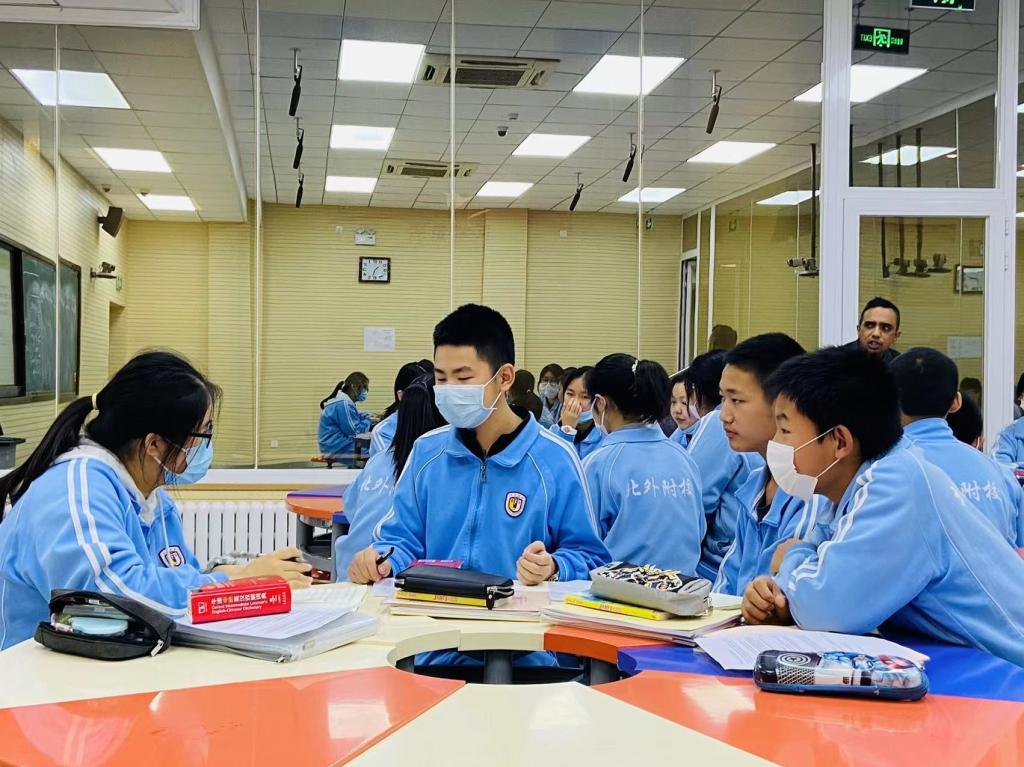为了全面提高组内教师教学水平,提升课堂教学质量,促进外籍教师之间相互学习和交流,初中高端英语项目组初二外教Mr.Jack和Mr.Tabish展示了两节不同课型却同样精彩的公开课,项目组中外籍教师观摩听课。
课堂一:奇思妙想,妙笔生花---Mr.Jack带你走进奇妙的语法写作世界
Mr.Jack给学生带来了一堂颇有挑战但不乏趣味,并激发学生奇思妙想的语法写作课。Mr.Jack先展示了本堂课的learning objectives让大家明确了本节课的学习任务。接着,通过例句让学生体会“the second conditional”第二条件句的具体用法,即表示现在或将来不可能实现,或实现的可能性很小的一种假设,并让学生通过观察例句进一步总结第二条件句的句式结构。

然后,教师通过设计不同的教学活动,来让学生熟悉主句和从句部分的不同结构,比如“If I were invisible, I would ___”, If I ___, I would run away”让学生发散思维,进行造句练习,或是句子改错。教师通过提供不同的情境或结果,让学生尽情发挥想象力并分享,充分调动了学生学习的积极性。

此外,Mr.Jack还补充了wish的用法,让学生更好的畅想和预设未来。接着,一张图片深深的吸引了大家的注意力—the monkey’s paw,得到它的人可以实现三个愿望,到那时许愿仅仅只是开始,由一个愿望会引起的一系列的变化,最终会如何结局呢,一切皆是未知。外教通过播放一个视频让学生了解猴爪,“If you received a monkey’s paw, what wishes would you make? How would they backfire?”如果你得到了一个猴爪,你会许一个什么样的愿望?愿望又会如何适得其反呢?Mr.Jack引导学生们开始了一场奇幻之旅。



课堂二:世界美味,美美与共---Mr.Tabish与你一起探讨美食与我们的联系
提及美食,最能让人回味的就是家乡小吃或是传统美食。美食给人带来的不仅仅是味觉上的享受,更能引发人们更多的思考。首先,Mr.Tabish以来自不同国家美食的视频引入world cuisine这个话题,激发学生学习的兴趣。随后,便通过美食图片让学生猜测所在的国家,并提问人们为什么会做不同的美食,学生们纷纷发表自己的观点, 如“满足生存的需求survival”,“给人们带来美好的回忆sweet memories”,更是“一种文化遗产cultural heritage”。

接着,教师让学生读一篇关于美食的文章,让学生从文章中明确美食和我们的联系。在文中,学生逐一分享对美食的理解:与家人的记忆、营养、怀旧、文化遗产等等。

最后,Mr.Tabish让学生们进行小组合作分享一个国家的美食,从人们什么时候吃这个食物,食物所包含的含义等方面进行探讨和分享。


在这两节公开课中,教师通过启发、例举、提问或反问等引导并激发学生思维,自然互动,有效促进了学生积极参与课堂。学生们用英语自信地表达,增强了英语学习的自信心,提升了英语学习的内驱力。

课后,中外教共同参与公开课的评课与交流,表达对本堂课的听后感受,有共鸣、也有思维的碰撞。此次公开课交流提升了教师专业素养和教学基本功,促进了全体教师专业自我发展。本次活动全程录像,资料组内共享,作为后续学习提高的资源。
【外教Mr.Jack的反思】
The open class introduced students to using the second conditional. The primary aims were understanding when to use the second conditional, becoming confident using it in a variety of contexts, understanding the grammar behind it, and using it to discuss the story of ‘the Monkey’s Paw’. The class progresses in difficulty, the opening questions being simple and familiar. By the end of the class, the content becomes reasonably advanced. The class used a mixture of writing, discussion, groupwork, videos and exercises to effectively communicate the information and keep students engaged. I chose the topic of the Monkey’s Paw as students were already familiar with the story as we had discussed it over Halloween. It was a topic that allowed them to be creative, to use the second conditional to express themselves, and seems to engage their interest.
The students remained engaged throughout the class, were able to complete the classwork with reasonable accuracy, and worked well with other students. I tried to involve every student in the class at some point. Students were willing to contribute and generally seemed to follow the discussions. If I were to teach the class again, I would provide more scaffolding for the writing task, as some of the students seemed to find it quite difficult.
公开课向学生介绍了使用第二个条件。主要目标是了解何时使用第二个条件,在各种上下文中自信地使用它,理解其背后的语法,并用它来讨论“猴爪”的故事。课程在难度中进行,开场问题简单而熟悉。到课程结束时,内容变得相当先进。该课程结合使用写作、讨论、小组合作、视频和练习来有效地传达信息并保持学生的参与度。我选择了猴爪这个话题,因为学生们已经熟悉了这个故事,因为我们在万圣节讨论过这个故事。这是一个让他们有创造力的话题,可以使用第二个条件来表达自己,并且似乎引起了他们的兴趣。
学生在整个课堂上都保持参与,能够以合理的准确性完成课堂作业,并且与其他学生合作良好。如果我再教这门课,我会为写作任务提供更多的语言支撑,让学生写得更加顺畅。
【外教Mr.Tabish的反思】
For my open class, I chose a topic to show the connection between food and culture. What motivated me to choose this topic is that students will be enthused by it plus it’s an important topic to remind us of the wonderful diversity that we have out there – food brings us closer to many cultures without even leaving our countries.
We started with some food and cultural related words that they would need to use throughout the lesson before we formally started the lesson, students wrote down the words. First, a world cuisine video was shown to pique their interest, and eliciting what they deduced from the video. They successfully highlighted the diversity that various cultures bring to the food. I also showed them pictures of food so they can guess where the dishes were from, this further aroused their interest on the connection between food and culture.
The lesson included strategies on how to gist and skim read, connect words associated with food & culture. The students discussed with each other the importance of food and culture, and gave their opinions. They also managed to delve further into the topic with the reading passage which was broken down into sub headings to better aid their learning and understanding. The task itself was both challenging and worthwhile for the students as they picked up new words plus understood how central food is to many cultures and vice versa. They also had the opportunity to work in a group by focusing on a particular country. Each group had a different country to present, hence, they learnt from each other the connection between food and culture in various parts of the world.
There was a clear weakness. The complexity of the text was challenging for the lower ability students, so I should have simplified the text even further. Perhaps debating strategies should have been adopted so students could have received the opportunity to practice their oral skills using the jargon.
对于我的公开课,我选择了一个展示食物与文化之间的联系的主题。促使我选择这个主题的原因是学生们会对它充满热情,它提醒我们外面的奇妙多样性——食物让我们无需出国就可以接近文化。
首先,我展示了一个世界美食视频来激起他们的兴趣,并引出他们从视频中得出的结论。他们成功地理解了各种文化给食物带来的多样性。我还给他们看食物的图片,让他们猜出这些菜是从哪里来的,这进一步激发了他们对食物和文化之间联系的兴趣。
另外,通过阅读让学生理解主旨、略读、猜测词义的阅读策略。最后,学生们互相讨论了饮食和文化的重要性,并发表了自己的看法。这项任务本身对学生来说既具有挑战性又值得,因为他们学会了新单词并了解食物对许多文化的重要性。
如果我再设计次课的话,我应该进一步简化课文帮助基础薄弱的孩子更好的理解。另外,也可以尝试采用辩论策略,以便学生有机会使用行话练习口语技能。